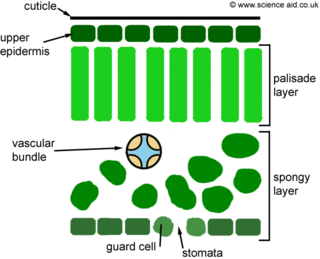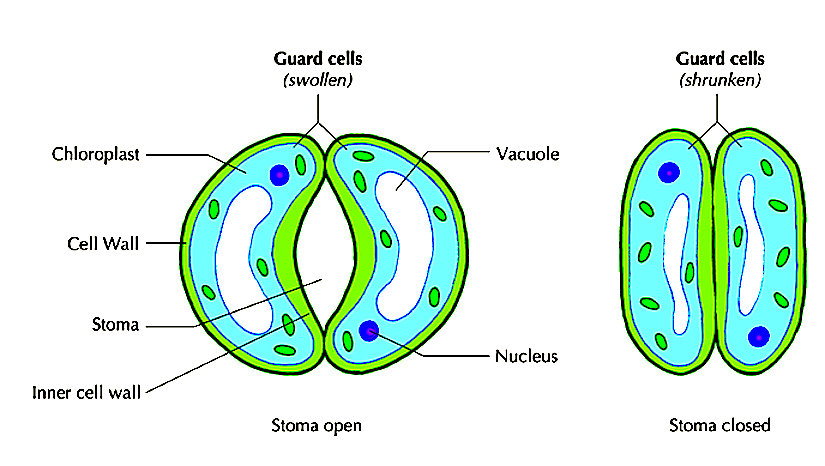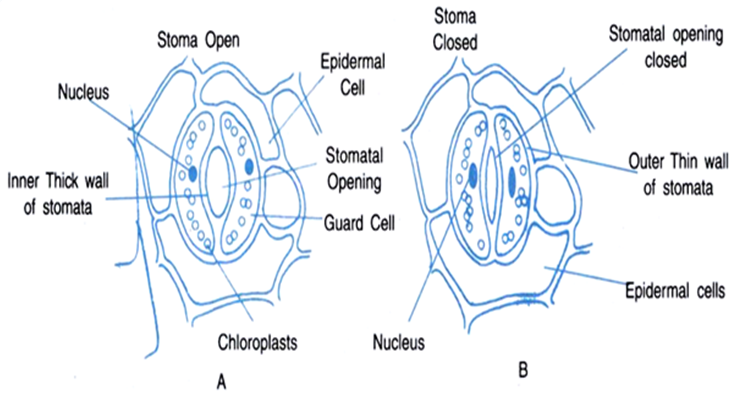41 guard cell diagram
Guard cells are a pair of two cells that surround each stoma opening. To open, the cells are triggered by one of many possible environmental or chemical signals. These can include strong sunlight or higher than average levels of carbon dioxide inside the cell. In response to these signals, the guard cells take in sugars, potassium, and chloride ... •opening is controlled by two guard cells. Leaves - Stomata . Guard Cells •Structure: paired, thick inner wall, has microfibrils •Function: controls the size of the stomata, the rate of gas exchange . How Guard Cells Work
Browse 22 guard cells stock illustrations and vector graphics available royalty-free, or search for stomata or photosynthesis to find more great stock images and vector art. Leaf anatomy vector illustration diagram. Biological macro scheme poster. Leaf anatomy vector illustration diagram.
Guard cell diagram
As with animal cells, the diagram of the plant cell above is a generalised diagram to show the structures. Plant cells can be varied also depending on their function. The diagram below shows the variety of cells in a leaf. ... Guard Cells: The lower surface of the leaf has little holes in it called stomata to allow gases to exchange. Each stoma ... In botany, a stoma (from Greek στόμα, "mouth", plural "stomata"), also called a stomate (plural "stomates") is a pore, found in the epidermis of leaves, stems, and other organs, that controls the rate of gas exchange.The pore is bordered by a pair of specialized parenchyma cells known as guard cells that are responsible for regulating the size of the stomatal opening. 4. Stomata are surrounded by two guard cells and two to many subsidiary cells. 5. The stomata open into a small cavity called the substomatal cavity. 6. The two guard cells that surround the stomata are kidney-shaped or bean-shaped. 7. The number and distribution of stomata and arrangement and distribution of subsidiary cells vary in different ...
Guard cell diagram. Diagram Of Stomata. Epidermal Cell: It is the outermost layer of plants. These specialized cells originate from the dermal tissues of the plant. Epidermal cells are irregularly shaped cells, which functions by providing mechanical support to the plant. Subsidiary Cell: These cells are located adjacent to the guard cell in the stoma of a leaf ... A solar cell, or photovoltaic cell, is an electrical device that converts the energy of light directly into electricity by the photovoltaic effect, which is a physical and chemical phenomenon. It is a form of photoelectric cell, defined as a device whose electrical characteristics, such as current, voltage, or resistance, vary when exposed to light.. Individual solar cell devices are often the ... Guard cells are specialized plant cells in the epidermis of leaves, stems and other organs that are used to control gas exchange. They are produced in pairs with a gap between them that forms a stomatal pore. The stomatal pores are largest when water is freely available and the guard cells turgid, and closed when water availability is critically low and the guard cells become flaccid. Photosynthesis depends on the diffusion of carbon dioxide from the air through the stomata into the mesophyll ti 4 C 2020 06100123 5 The diagram shows the structure of a plant cell. What is a function of this specialised plant cell? AIt absorbs carbon dioxide from the air. BIt absorbs ions from the soil. CIt transports sucrose from leaves. DIt transports water in stems. 6 The photograph shows a chloroplast magnified ×7000. 70 mm What is the actual size of the chloroplast?
The guard cells are living and contain chloroplasts. Their inner walls (wall towards opening) are thicker and outer walls thinner. Fig. 6.4. Structure of stomata. (A) Stomatal pour is open. (B) Stomatal opening is closed Function of guard cells: The guard cells regulate the opening and closing of the stomatal pore. The guard cells swell when ... Jun 18, 2021 · Guard cells are a pair of bean-shaped cells found in the epidermis of leaves and young stems of plants. They look similar to a kidney and exist in pairs surrounding a tiny gas exchange opening called a stoma. Guard cells help plants to perform photosynthesis, get rid of wastes, and excess water. Guard Cells Diagram. Each stomatal apperture is guarded by a pair of pea-shaped specialized cells called chloroplast-containing guard cells, these are the cells which regulates the opening and closing of stomata. The guard cells are surrounded by subsidiary cells. The inner wall of guard cells is thick whereas the outer wall is thin in structure. The histochemical and immunocytochemical structure of the guard cell wall is discussed in the light of its multiple functions, most of which involve changes in cell size and shape. Beta vulgaris L. , callose , guard cell wall , pectin , xyloglucan.
The cell wall where 2 phloem cells join together has holes which allows the cytoplasm of both cells to communicate passing down the dissolved food. 4. Guard cell (stomata): Allows O2 and CO2 to pass in and out the leaf. They can change their shape thus can open and close their holes. 5. Red blood cells: It transports oxygen from the lungs to ... When water flows into guard cells these swell causing the stomatal pores to open and the pores close if the guard cells shrink. The raw materials such as water, nitrogen, phosphorous etc. used in photosynthesis are also taken up by the plants from different sources. Water is absorbed by plants from the soil by the roots in terrestrial plants. A chromosome → gene → nucleus → cell → tissue ... 3 The diagram shows the movement of water through part of a leaf. ... guard cell Which processes are involved in the movement of water at these stages? 1-2 3-4 4-5 A diffusion evaporation osmosis B evaporation diffusion osmosis First, ribosomes can float freely within the cell's cytoplasm. Otherwise, ribosomes can also be attached to a cell structure that is known as the endoplasmic reticulum. As the cell's protein factories, ribosomes locate and combine disparate amino acids using peptide bonds in order to create more complex polypeptide structures (proteins).
Q: Which one of the following conditions is true for the state of stomata of a green leaf shown in the given diagram? (a) Large amount of water flows in to the ground cells. (b) Gaseous exchange is occurring in large amount. (c) Large amount of water flows out from the guard cells. (d) Large amount of sugar collects in the guard cell
Subsidiary cell Epidermal cell Guard cell Stomatal aperture 3.Guard cell Stomatal aperture Subsidiary cell Epidermal cell 4.Epidermal cell Guard cellStomatal aperture Subsidiary cell. Solve Study Textbooks. Join / Login. Question . Given below is the diagram of a stomatal apparatus. In which of the following, all the four parts labelled as A, B ...
Guard cells ... The diagrams show a cheek cell from a human and a leaf cell from a plant. (a) The two cells have a number of parts in common. ...
Secretory Vesicle: Cell secretions - e.g. hormones, neurotransmitters - are packaged in secretory vesicles at the Golgi apparatus.The secretory vesicles are then transported to the cell surface for release. Cell Membrane: Every cell is enclosed in a membrane, a double layer of phospholipids (lipid bilayer).The exposed heads of the bilayer are "hydrophilic" (water loving), meaning that …
What are guard cells? A pair of guard cells surrounds each stoma on the leaf surface. Stomata are important because they regulate the uptake of CO2 from the atmosphere for photosynthesis and also the loss of water vapour from the plant during transpiration. The aperture of the stomatal pore is controlled by the two guard cells. When the guard cells are fully turgid the pore gapes open, whereas ...

Image from page 38 of "Cyclopedia of farm crops : a popular survey of crops and crop-making methods in the United States and Canada" (1922, c1907)
(e)€€€€€The diagram below shows two guard cells surrounding a closed stoma and two guard cells surrounding an open stoma. € When light intensity is high potassium ions are moved into the guard cells. Describe how the movement of potassium ions into the guard cells causes the stoma to open.
10 The diagram shows a cross-section through a plant stem. Q Q shows the part that is stained red when the stem is placed in water containing a red dye. What is found at Q? A guard cells B palisade cells C phloem D xylem 11 What could increase the rate of water uptake by a shoot? A covering the shoot with a black plastic bag
Fig. 6.5: Guard cells and epidermal cells: (a) lateral view, (b) surface view (a) (b) Guard cell Stoma Epidermal cell Guard cells parts of the plant often secr ete a waxy, water - resistant layer on their outer surface. This aids in pr otection against loss of water , mechanical injury and invasion by parasitic fungi. Since
Structure of Stomata. It has an average length and breadth of 10 to 40 µm and 3 to 10 µm, respectively. Stoma varies in shape and size to adapt to different environmental conditions, ensuring optimal conditions for photosynthesis. It is made of two guard cells - a pair of specialized, kidney-shaped epidermal cells.
Dec 08, 2021 · Diagram & Graphics Diagram & Graphics Products. ... For families, it is the best digital guard to protect kids from 2-18. Parents can install this app easily in three steps. Features: Filter out explicit search results and block words to search on all browsers. ... While Net Nanny is a popular parental controls App for android cell phones that ...
walls of the cell; moreover, this wall lacks plasmodesmata and is impregnated with cutin and waxes. In guard cells, the side of the wall adjacent to the stomatal pore is much thicker than the walls on the other sides of the cell. Such variations in wall architecture for a …
Essentially, guard cells are two bean-shaped cells that surround a stoma. As epidermal cells, they play an important role in gaseous exchange in and out of plant leaves by regulating the opening and closing of pores known as a stoma. In addition, they are the channels through which water is released from leaves to the environment. As such, guard cells play a crucial role in photosynthesis by regulating the entry of materials necessary for the process. Apart from regulating gaseous exchange (as well as water release from leaves), they have also been shown to contain chloroplasts which also make them a site of photosynthesis. Some of the factors that influence guard cell activities include: 1. Humidity 2. Temperature 3. Light 4. Carbon dioxide 5. Potassium ions 6. Hormones *In Greek, the word "stoma" means mouth. *Although stomata are commonly found in plant leaves, they can also be found in the stems.
by A Hetherington · 2001 · Cited by 3 — R588 Current Biology Vol 11 No 15. What are guard cells? A pair of guard cells surrounds each stoma on the leaf surface. Stomata are important.1 page
The epidermal cells bordering the guard cells are called accessory cells or subsidiary cells. Generally the term stoma is applied to the stomatal opening and the guard cells. The guard cells are living and contain chloroplasts in them. They also contain a larger proportion of protoplasm than other epidermal cells.
Given below is the diagram of a stomatal apparatus . In which of the following all the four parts labelled as A , B,C and D are correctly identified ? A. A- Subsidiary cell B-Epidermal cell C-Guard cell D- Stomatal aperture B. A- Guard cell B- Stomatal aperture C-Subsidiary cell D-Epidermal cell C. A-Epidermal cell B- Guard cell C- Stomatal ...

Image from page 39 of "Cyclopedia of farm crops : a popular survey of crops and crop-making methods in the United States and Canada" (1922, c1907)
Guard cells are surrounded by stomatal pores and are located in leaf epidermis. Guard cells control influx and efflux of CO2 and water from leaves, respectively ...
The uppermost and lowermost layers are the epidermis; the epidermis is covered by a cuticle and has stomata (pores) with guard cells that can open and close the pores. Filling the space inside the leaf is the mesophyll, with upper palisade parenchyma (columnar cells) and lower spongy parenchyma (irregularly-shaped cells).
Introduction. Guard cells as a unique plant single cell-type perform many functions essential to plant growth and survival. Each pair of guard cells and the regulated pore they enclose, known as a stoma or stomate, provides a conduit for atmospheric photosynthetic gas exchange (CO 2 uptake and O 2 release) and transpirational release of water (H 2 O) in terrestrial plants, in addition to ...
The opening and closing of stomata depend upon the turgid or flaccid state of guard cells. When the guard cells are in a flaccid state, the stomatal aperture closes. During the daytime, as a result of photosynthesis (guard cells have chloroplast) concentration of carbohydrate rises, leading to osmotic uptake of water by the guard cells. Thus ...
Unlike pavement cells, guard cells are more specialized with a definitive shape that allows them to carry out their functions. With regards to structure, two guard cells form the stomata. Depending on water availability (as well as the concentration of sugars and ions), guard cells can become turgid which controls the closing and opening of the ...
The shape of guard cells resembles bean or kidney shape. Guard cells always exist in pairs. Between each pair of guard cell, a stomatal pore is present. They are covered by a layer of cuticle that is highly permeable to water vapour and polar substances. The cell of guard cells is thick towards the opening of
Aug 31, 2021 · Guard Cell Labelled Diagram. angelo. August 31, 2021. Photosynthesis Leaf And Pigments Epidermis Leaf Structure Cell Structure. Animal Vs Plant Cells Nice Unlabeled Diagrams Exploring Nature Plant Cell Diagram Cell Diagram Plant Cell. Chloroplast Diagram Photosynthesis Plant Cell Biology. Plant Sciences Stoma Plant Science Plant Structure.
Q. The diagram below shows a process of inhalation. Based on the diagram, choose the correct two statements about the process. ... Q. Guard cell contain chloroplast for _____ process. answer . photosynthesis. photosynthesis . alternatives . Tags: Question 10 . SURVEY .
Download scientific diagram | Simplified diagram of guard cell ABA and blue light signaling highlighting protein phosphorylation events.
Structure X contains guard cells that regulate glucose intake. Structure X carries out heterotrophic nutrition. Structure X produces gametes for asexual reproduction. Structure X transports materials for metabolic activities. Tags: Question 6 . SURVEY . 180 seconds . Q. Which process is most closely associated with the regulation of water loss ...
The cell wall surrounding the pore is tough and flexible. The shape of guard cells usually differs in both monocots and dicots, though the mechanism continues to be the same. Guard cells are bean-shaped and contain chloroplasts. They contain chlorophyll and capture light energy. The subsidiary cells surround the guard cells.
4. Stomata are surrounded by two guard cells and two to many subsidiary cells. 5. The stomata open into a small cavity called the substomatal cavity. 6. The two guard cells that surround the stomata are kidney-shaped or bean-shaped. 7. The number and distribution of stomata and arrangement and distribution of subsidiary cells vary in different ...

Image from page 123 of "Apple pollination studies in the Annapolis Valley, N.S., Canada, 1928-1932." (1933)
In botany, a stoma (from Greek στόμα, "mouth", plural "stomata"), also called a stomate (plural "stomates") is a pore, found in the epidermis of leaves, stems, and other organs, that controls the rate of gas exchange.The pore is bordered by a pair of specialized parenchyma cells known as guard cells that are responsible for regulating the size of the stomatal opening.
As with animal cells, the diagram of the plant cell above is a generalised diagram to show the structures. Plant cells can be varied also depending on their function. The diagram below shows the variety of cells in a leaf. ... Guard Cells: The lower surface of the leaf has little holes in it called stomata to allow gases to exchange. Each stoma ...































Komentar
Posting Komentar